What to Wear For Your First Dayhike
This article originally appeared on Backpacker
Hitting the trail for the first time? Time for a 'fit check. Fashion might not be very important while hiking, but what you wear can make the difference between a fun time and a miserable one. However, that doesn't mean you need to go out and buy a whole new wardrobe for your first hike--in fact, you may already have the right outfit ready to go. Dress appropriately with these tips.
Check the Weather
It's a no-brainer: You can't decide what to wear until you know what conditions you're dressing for. Keep in mind that the weather at the trailhead or in a nearby town won't necessarily be the same as at your hiking destination. High elevations and summits tend to be colder and windier than lower spots, and storms may be more likely. Prepare for the absolute worst weather you might encounter--it's better to be overprepared than underprepared.
Use What You Have
Hiking-specific apparel is great, but for your first hike, you likely already have what you need in your closet. Moisture-wicking activewear like what you’d wear to the gym or on a run functions on most hikes, too. Choose clothing that's comfortable, flexible, and protects you from weather, spiky or poisonous plants, and bugs.
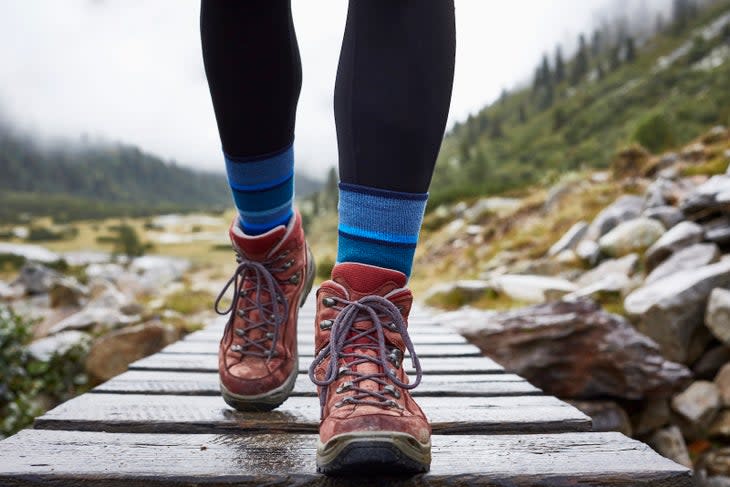
What Shoes to Wear Hiking
Sore feet lead to a bad time on trail. For your first few hikes, wear any sturdy, closed-toe athletic shoes you have. (Just pick a pair you don't mind getting dirty.) Sneakers are fine for most easy to moderate trails, but you may want shoes with some extra traction and support for steep hikes. Ready to buy a pair of hiking-specific shoes? You've got some options.
Trail Runners and Hiking Shoes
Don't let the name fool you: trail running shoes aren't just for moving fast. Many hikers opt for these over boots because they're light and nimble while still offering grip and support. (They also cut down on fatigue by reducing the amount of weight your legs are lifting with each step.) For dayhiking or even backpacking under light to moderate loads, trail runners are a great option. Try these if you don't need extra ankle support and like feeling unencumbered by clunky footwear, or if you like moving fast.
For dayhikes and treks with a light or medium-weight backpack, try a low-top hiking shoe, which should have a stiffer feel and more support than an average trail runner. They often include burlier uppers too, which can shrug off abrasion from sharp or rough rocks
Hiking Boots
If you're prone to ankle injuries or will be carrying a heavy pack, go for a boot with ankle support. Most hikers opt for mid-cut boots, which rise to just above the ankle bone These are great for long treks, though they are are often overkill for short dayhikes. One thing you likely want to avoid: high-rise, combat-boot-style footwear, which is often heavy and can lead to blisters if not adjusted and laced just right.
Materials
Consider waterproofing and breathability when picking out hiking shoes. If you'll be spending lots of time crossing shallow streams, hiking through snow or mud, you might want waterproof boots. Just keep in mind that these boots tend to be far less breathable than their non-waterproof counterparts. That means that sweat gets trapped, and if you overtop the boots in a deeper stream or puddle, they'll take longer to dry. For summer hiking, many hikers prefer breathable, synthetic shoes (like those with mesh paneling) that dry faster if they do get wet.
In addition to upper material, consider the outsole, which is what anchors you to the trail. Different soles are engineered for different surface types; if you hike often in slippery mud, you may want larger, well-spaced lugs. If you anticipate lots of rock scrambling, look for sticky rubber and flatter soles that maximize surface contact with the ground.
With so many models out there, it's a good idea to try on various pairs in the store and feel what works best for you. As you hike more, your preferences might change. Just make sure you get a well-fitting shoe or boot that's supportive enough for the type of terrain you plan to hike in. A sales associate at your local retailer can help you dial in fit. Especially for burly hiking boots and leather footwear, make sure you plan for a break-in period instead of taking your shiny new boots straight out on the trail.
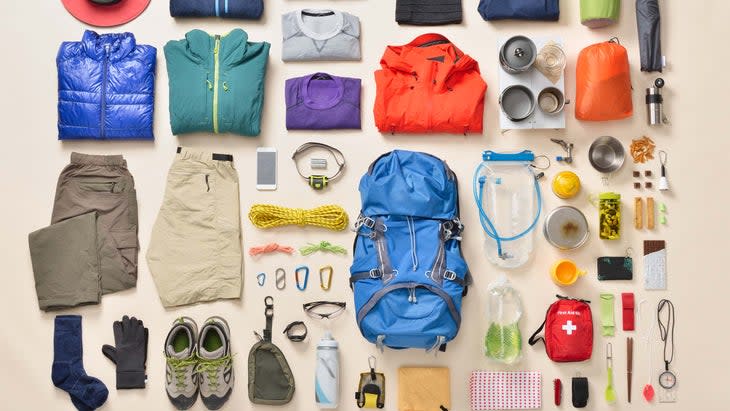
Hiking Bottoms
In summer, running shorts are suitable, as long as you won't be trekking through thorny bushes or encountering low temperatures or swarms of mosquitoes. Leggings or flexible, breathable pants offer more protection than shorts--just keep in mind that leggings tear easily on sharp objects. Look for pants that will dry quickly if they get wet (avoid cotton, see below) and are light enough to prevent you from overheating. Choose durable fabrics over thin ones, especially if you'll be scrambling over rocks or walking through branches and low brush. You want a comfortable fit that allows freedom of movement for high-stepping over fallen logs and navigating uneven trail.
Hiking skirts or skorts are a great option for hikers who want more freedom of movement and breathability (don't knock it 'til you try it). Pairs with built-in spandex shorts are preferable.
Hiking Tops
Athletic tops are better for hiking than regular T-shirts, as they wick sweat away from your skin to keep you dry and comfortable. Avoid tank tops if you'll be wearing a heavy backpack--the straps might chafe bare shoulders.
In colder temperatures, some hikers might prefer long-sleeve shirts. If you typically run cold, long-sleeved baselayers or synthetic T-shirts can help you regulate your temperature. Just keep in mind that you'll generate plenty of heat while hiking, especially on strenuous uphills. You can always opt for a short-sleeved shirt with a light long-sleeve on top and adjust as necessary.
Underwear for Hiking
Underwear
For your first hike, wear whatever you feel comfortable in. Got a favorite pair of boxers for working out? Chances are you'll be happy in them on the trail, too. As you start going for longer hikes, overnights, and backpacking trips, your preferences might change. Most hikers prefer synthetic or wool underwear instead of cotton (you’ll be sweating, and no one likes to feel damp). Just make sure you wear something that's comfortable for extended durations of movement--prominent seams that might cause chafing are a no-no.
Sports Bras
Sports bras are generally more comfortable for hiking than regular bras. If you're wearing a heavy pack, go for a bra with low-profile or wide straps; avoid chunky buckles or large seams, which could cause chafing under backpack straps. Again, your favorite sports bra for other activities is likely good for hiking, too.
Socks
For most items on this list, any athletic apparel will do. But if there's one area to splurge for hiking-specific garments, it's socks. A good pair of socks can make the difference between a pleasant hike and one that ends in blisters and pruney toes.
Hiking socks are made of wool or quick-drying synthetic material, provide some cushioning that will keep your feet comfortable over long miles, and often fend off blisters better than regular socks. To avoid chafing and maximize comfort, opt for a pair of socks that are taller than the cuffs of your hiking footwear. Look for wool or synthetic socks with a weight appropriate for the temperatures in which you'll be hiking (lighter in the summer, heavy in the winter). Choose the cushion level that feels right for you--just make sure your socks fit well, as bunching or slipping can lead to discomfort and, ultimately, blisters.
If you're prone to blisters, you may want to try wearing liner socks under your hiking socks to minimize friction against your skin. Compression socks promote blood flow and accelerate recovery, and are the choice of many trail-runners and long-distance hikers.
For overnights, wet, or cold hikes, stash an extra pair of dry socks (or two) in your backpack.
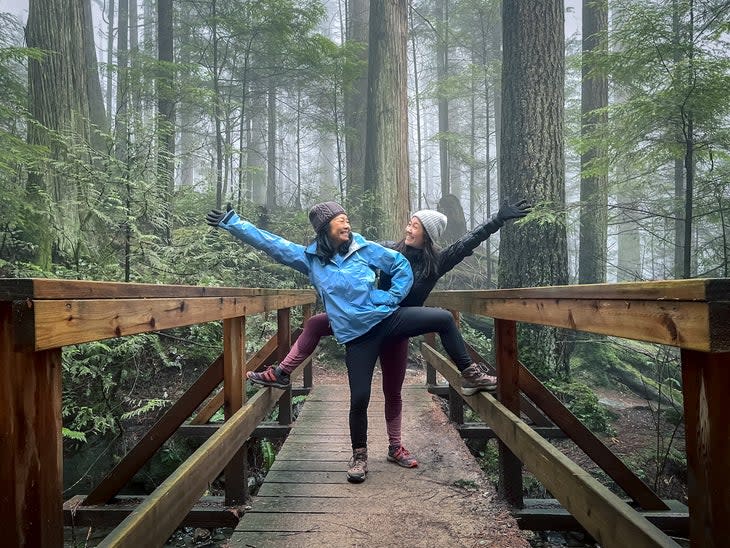
Layering for a Hike
On the trail, it's all about having options. Conditions might change as you hike, and your body temperature will fluctuate between periods of exertion and rest. Wear light layers against your body (shorts, pants, and a short-sleeve top in the summer, and baselayers in cold conditions).
Unless you're hiking somewhere that nighttime temperatures are consistently above 70, always wear or carry a midlayer, such as a fleece or wool hoodie. It might be scorching at your car, but you never know when you might get chilly during your hike.
In colder temperatures, an insulating layer like a puffy jacket is a good idea. Stash it in your pack while you hike, and pull it on to preserve warmth while you snack or take in the views. For cold hikes, bring a warm hat and gloves or mittens. It's never a bad idea to pack two pairs of gloves: a light pair for while you're moving, and a warmer pair for when you're stopped.
Sun Protection
Especially at high elevations, you'll want to do what you can to avoid sunburn (yes, even in winter). In addition to packing sunscreen, wear a brimmed hat and sunglasses. Light, long-sleeve shirts like sun hoodies can be a lifesaver on exposed trails.
Rain Protection
If there's even a small chance of precipitation in the forecast, pack a rain jacket. Any waterproof layer you have will do for short dayhikes. For long trips or hikes in very wet climates, make sure you have a waterproof hardshell. When in doubt, a poncho is an affordable option that will keep you dry in most conditions.
Rain pants aren't necessary for most dayhikes, but they're great when staying dry is a priority: On rainy backpacking trips, in torrential downpours, or when you're especially concerned about staying warm. Rain kilts are a more breathable option for keeping your legs dry in a downpour, though they won't keep out sideways squalls.
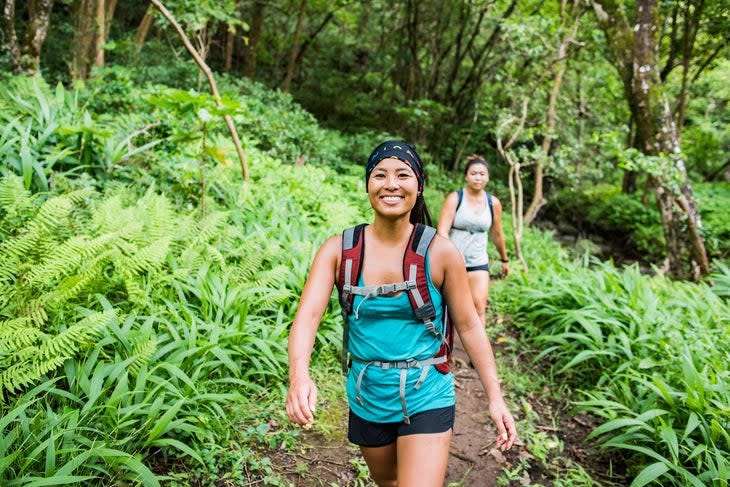
Hiking Clothing Materials
Fabric choices abound when it comes to choosing what to wear hiking, and each has its own pros and cons. Here's a rundown of the most common materials used in hiking apparel.
Nylon
This synthetic material is popular in hiking clothes for its superior durability and decent wicking capabilities. Nylon absorbs some water, so garments made from it may dry more slowly than other materials. While nylon can withstand scrapes and snags better than most other materials, it's not as light as polyester or polypropylene.
Polyester
This synthetic is the choice material for it's wicking and fast-drying abilities. If you sweat a lot or want a garment that won't stay wet after stream-crossings and rain showers, opt for polyester, which is also durable and. Keep in mind that polyester clothes often hold odors more than other materials.
Wool
Wool offers a soft on-skin feel, and is a superior insulator for cold-weather hiking. It breathes well, keeping you warm without causing excess sweating. Wool garments tend to stretch, but they're less durable than synthetic fabrics and don't dry as fast. Plus, wool tends to be more expensive than other materials.
Polypropylene
Once a ubiquitous material in hiking clothes, this material is now mostly found in blends. It's less breathable than polyester and nylon, but does a good job of trapping heat.
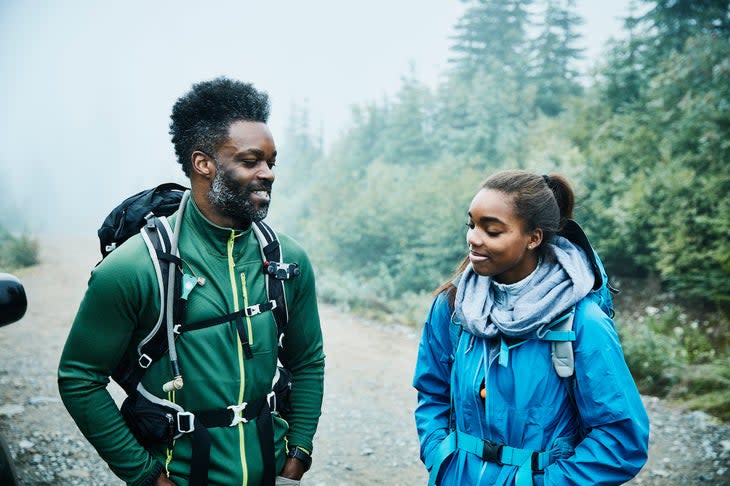
Adapting Your Hiking Clothes for Each Season
Of course, what you choose to wear hiking in each season is highly dependent on your location. But in general, some easy adaptations can take your hiking outfit from season to season.
Winter
When the mercury drops, it's all about layers. Go for baselayers, insulating layers, and water- and wind-proof outer layers to protect you from the elements. Not ready to splurge on a winter hardshell? Your rain jacket can work well in the snow, too, as long as it fits over your warm clothing.
Gaiters and vapor barriers paired with warm socks can help your hiking boots make it in snowy conditions.
Spring
The weather can be unpredictable this time of year. Carry extra warm layers in your backpack in case temperatures fluctuate during your hike, and prepare for rain. Want to be ready for anything? Zip-off pants or a pair of shorts worn over leggings allow you to adapt on the trail. Spring is mud season, so wear shoes or boots with widely-spaced lugs.
Summer
This warm season is the easiest to dress for. Account for sun protection, and carry an insulating layer if you'll be hiking to high altitude or after dark.
Fall
Just like in spring, expect all sorts of conditions in autumn. Pack a wind-blocking layer (your raincoat can double as a windbreaker), hat, and gloves.
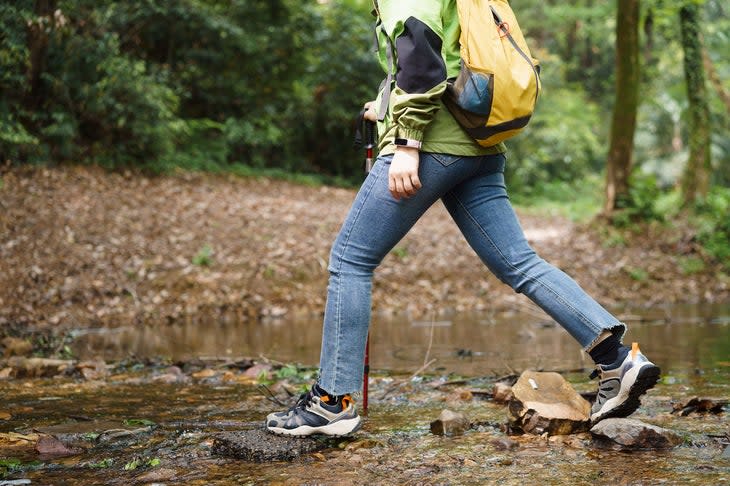
What Not to Wear Hiking
Cotton
Normal T-shirts, denim jeans, sweatpants, sweatshirts, and other cotton apparel might serve you fine on short jaunts in the woods, but for serious hikes, leave them at home. Cotton retains moisture, making you clammy at best, and at worst, it sucks heat and leaves you hypothermic. Opt for wicking materials instead like wool or synthetic shirts and fleece layers. The exception: hikes in extremely hot, dry climates, where cotton's cooling properties can help keep you from overheating.
Clothes You Care About
You're going to get dirty, sweaty, and maybe even a little roughed up on the trail. That's all part of the fun. If you'd be devastated to stain or rip an item of clothing, don't wear it on a hike.
Updated in May 2023
For exclusive access to all of our fitness, gear, adventure, and travel stories, plus discounts on trips, events, and gear, sign up for Outside+ today.

